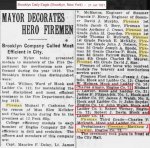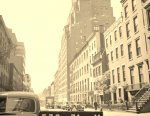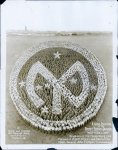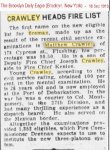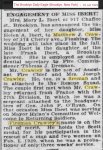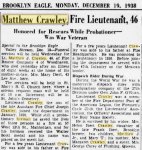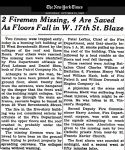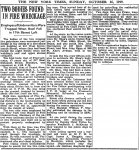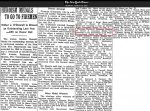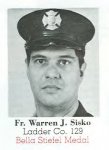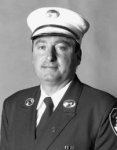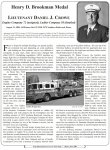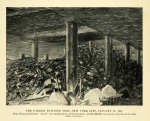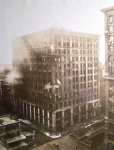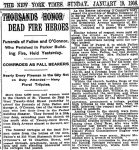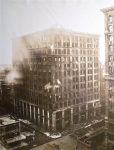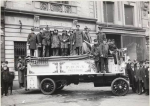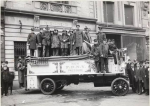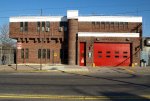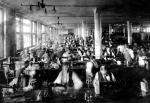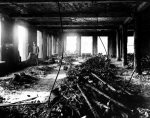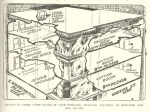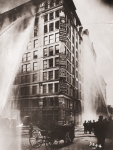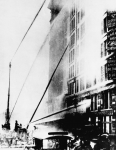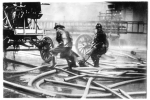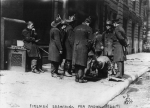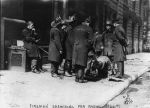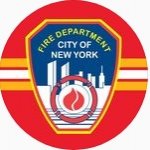ENGINE 72/SATELLITE 2 3929 TREMONT AVENUE THROGGS NECK, BRONX DIVISION 7, BATTALION 20 “NEVER A DULL MOMENT”
ENGINE 72 FIRE - 1902
 New York, NY Park Avenue Hotel Fire, Feb 1902 - part 1
New York, NY Park Avenue Hotel Fire, Feb 1902 - part 1
Submitted by Stu Beitler
New York, New York
Park Avenue Hotel Fire
February 22, 1902
SIXTEEN PERISH IN PARK AV. HOTEL
Swift Moving Flames Destroy Lives on the Upper Floors.
THRILLING ESCAPES MADE.
Seventy-first Regiment Armory Destroyed by Fire Just Before the Hotel Caught.
SEVERAL KILLED BY JUMPING
Fire Thought to Be Incendiary --- MRS. FOSTER, the Tombs Angel Killed in the Fire.
Sixteen persons lost their lives and about fifty others were injured in a fire in the Park Avenue Hotel, at Park avenue, between Thirty-second and Thirty-third streets, Manhattan, early this morning.
All of the dead and injured were guests of the hotel, many of them from out of town. Most of them had rooms in the upper stories of the hotel, and when the fire, which is of mysterious origin, reached their rooms they were hemmed in by smoke and flame and cut off from escape. One of the dead is MRS. FOSTER, well known as the Tombs' Angel.
The Dead.
PIPER, ALEXANDER A., colonel, U.S.A. Retired.
HORN, THOMAS P., of Denver, Col.
IVISON, WILLIAM, of Denver, Col.
ROBBINS, GASTON A., of Alabama.
WALKER, WILLIAM, of Tennessee.
FOSTER, MRS., known as the “Tombs' Angelâ€
BURNHARDT, W. G., of Chicago.
BURDETT, Colonel CHARLES L., First Infantry, U.S. Vol., Conn.
BENNETT, MRS. CHARLOTTE, of Alabama.
HOVEY, FREDERICK, of Lyons, N. Y.
O'CONNELL, CHARLES UNDERWOOD.
SCHLESINGER, MISS ESTHER, of Chicago.
SPAHN, JACOB, of 34 Concord street, Rochester.
Unknown woman, supposed to be MRS. E. W. McGINNISS.
The Injured.
The following persons are known to have been injured:
BENNETT, HAROLD, face and hands burned; Bellevue Hospital.
BROOKMAN, WILLIAM S., the Rev., Norfolk Conn., burns.
BENNETT, MARAGARET E., 26 years old, Park Avenue Hotel, face and hands burned; Bellevue Hospital.
GOVE, WILLIAM A., 52 years old, Park Avenue Hotel, suffocation and burns, shock; New York Hospital.
GREGORY, CHARLES A., 67 years old, lawyer, Park Avenue Hotel, face and hands burned; Bellevue Hospital.
HALL, CAROLINE I. R., 79 years old, 29 Hill street, Newark, N. J., widow, body burned and shock; New York Hospital.
HALL, ANNA G., 56 years old, single, 29 Hill street, Newark, N. J., body burns and shock; New York Hospital.
HALE, WILLIAM B., Williamsville, Mass., suffocated; New York Hospital.
HEARNE, E. S., 40 years, Atlanta, Ga., burns of body; Bellevue Hospital.
LIVINGSTON, EMILY I., 49 years old, Park Avenue Hotel, guest on fourth floor, burns of face and body; Bellevue Hospital.
PEARSU, JOSEPH, 62 years old, feeble, Park Avenue Hotel, overcome, hysterical; to Bellevue Hospital from home of J. E. GARVIN, 516 Park Avenue, burned about face and hands, not serious.
STEBBINS, WILLIAM, 85 years old, of West Indies, Park Avenue Hotel for five months, hands and face burned.
WOODBURY, LEWIS G., 244 Stanton street, Portland, Oregon, Park Avenue Hotel, burns of hands and face; Bellevue Hospital.
REED. FRANK R., proprietor of the Park Avenue Hotel, burned about the face and hands in carrying his wife to safety from the fourth floor.
REED, MRS. FRANK R., wife of the proprietor, burned about face and hands.
BRIDGEMAN, MR., guest of Park Avenue Hotel, burns.
LYONS, ______, 24 years old, of 145 East Twenty-second street, cut by falling glass while in Thirty-third street.
BARRY, LOUIS, 50 years old, of Portland, Me., shock, was rescued by Policeman TYRALL.
VEACH, MRS. S., guest of the hotel on fourth floor, burned about the face, hands and body.
Seventy-first Regiment Armory, Opposite the Hotel, Destroyed by Flames.
Coincident with the fire that caused such loss of life in the Park Avenue Hotel, another fire razed to the ground the handsome armory of the Seventy-first Regiment on Park avenue, between Thirty-third and Thirty-fourth streets, diagonally across the street from the hotel. There was some talk this morning to the effect that the fire in the hotel was directly due to the fire in the armory and that the former originated in the flames and sparks that filled the air in the neighborhood while the armory was burning. There was a theory that some of these sparks or lighted pieces of wood from the burning armory had lighted on the hotel and started the blaze there.
Hotel Fire Probably Not Due to Armory, but Possibly Incendiary.
It is not likely that such was the case, however. All the indications are that the fire in the hotel was an independent one, and did not originate in the blaze that destroyed the Seventy-first Armory. In fact, Proprietor REID of the Park Avenue Hotel said after the fire was over that he believed it was of incendiary origin. He says the fire started in the cellar near the elevator shaft and shot up through the building, filling it with flames and smoke before the sleeping guests were aware of their danger. This is also the theory of Fire Chief CROKER, who was one of the early arrivals on the scene of the fire.
Lives Were Lost on the Upper Floors.
If is a peculiar fact that most of the people who lost their lives were living in the upper stories of the hotel, a great many of them on the fifth floor, where the greatest damage was done and where the greatest casualties took place.
There were many peculiar features connected with the fire. It is asserted by the people connected with the hotel, by guests who escaped with their lives and by the police and firemen that many of the windows of the hotel were thrown open soon after the fire in the armory across the street by persons anxious to get a view of the spectacle. This was particularly the case in the upper stories of the hotel, yet it was here that most of the people who suffered death in the flames were living. It is regarded as singular that people whose windows were opened evidently by themselves should be caught in the flames.
Flames Swept Through the Hotel at Lightning Speed.
It is explained that in five minutes after the fire started in the hotel the whole elevator shaft and the corridors opening on it were a mass of flames and that little or no opportunity was afforded to the imperiled guests to make their way out.
The first three stories of the hotel were untouched by the fire, but were considerably damaged by water. The upper stories of the hostelry are a wreck.
First Fire Started in the Armory.
The first fire was that in the armory of the Seventy-first Regiment -- started about 1:30 A. M. on the third floor of the building on the Thirty-third street side. This part of the building was occupied by the First Signal Corps. The building was also the headquarters of the Fifth Brigade, the Second Battery and the Seventy-first Regiment Veteran Association. The fire was discovered by a woman, who ran to the headquarters of Battalion Chief ROSS in Thirty-third street near Lexington avenue, and gave the alarm. ROSS hurriedly went to the scene and turned in two other alarms. By the time he got there the whole building was a mass of flames.
Rapid Transit Subway Hampered the Firemen.
To make matters worse the armory is situated right above the excavations for the rapid transit subway and trolley cars pass in front of the Park avenue side of the building. The firemen had the greatest difficulty in making their way through the obstructions in front of the building and meanwhile the armory was burning like a tinder box.
ANDREW PATTERSON, the armorer, lived in the armory with his family, and when the fact became known that there was a fire in the building an Italian engineer, employed on the rapid transit subway, named JOSEPH CACCAVAJO, got out of bed, and, running over to the armory, began to pound on the door with all his might. It was several minutes, however, before he could rouse the armorer and apprise him of his danger. PATTERSON was finally got out of the building with his wife and children safely.
By this time it became evident that with the high wind blowing, the armory was doomed. The entire structure was a mass of flames. Fire Chief CROKER came on the scene and ordered a fourth alarm rung.
Ammunition Stored in the Armory Explodes.
In the headquarters of the Fifth Brigade, on the Thirty-fourth street and Park avenue corner of the armory, there was stored a great quantity of ammunition. It consisted of blank and bullet cartridges. These cartridges began to explode as soon as the fire heated them. Bullets flew and the reports from the cartridges came thick and fast. For a time the firemen were afraid to go too near the building at the corner where the ammunition was stored. Gradually the explosions ceased and the firemen were able to get in to closer fighting range. At this time it was learned that about a thousand pounds of powder was stored, it is said, in the basement of the armory. It was in the sub-cellar, in the southeast corner of the building, near Thirty-third street. At 2:10 o'clock this exploded with a detonation that could be heard for blocks. It shook the entire structure, and then the Thirty-third street wall of the armory fell in.
At this time it was seen that the armory was entirely doomed, and the firemen were directed to turn their attention to the car barns of the Metropolitan Street Railway, directly across the street, south of the armory.
Hotel Did Not Seem to Be in Danger.
At that time it was not thought that the Park Avenue Hotel was seriously menaced, although Proprietor FREDERICK A. READ of the hotel had two score of men on the roof of the structure sweeping off the sparks and burning brands that fell there.
The armory is a complete wreck. Only the four walls of what was once of the finest structures of its kind in the country are left standing as a result of the fire. The interior of the building is a pile of hot, smoking ruins.
Hotel Fire Starts Before Armory Fire Is Over.
The firemen had scarcely got through fighting the fire in the armory when they were compelled to turn their attention to the Park Avenue Hotel, which was seen to be burning. From the windows of the upper floors of the hotel smoke and flames were pouring in dense quantities. Immediately Chief CROKER sent in a fifth alarm.
Many miraculous escapes characterized the fire in the hotel and there were several heroic rescues.
Chief CROKER called Captain KENLON of Engine 72, who was stationed on the Thirty-third street side of the armory, and sent him to the hotel. KENLON took a line of hose and with his men dashed through the main entrance of the hotel, in the center of the block on Park avenue. He found his hose was too short, as most of it was in use in other places. The men of the company dropped their line and were ordered to find a hose inside the hotel which they could couple onto their own and thus do effective work against the rapidly spreading flames.
Firemen Could Find No Hose in the Hotel.
Fire Chief CROKER later said KENLON'S men were unable to find a line of hose on the third, fourth or fifth floors of the house. The search was kept up on the sixth and seventh floors. No better success was had. All this time the fire spread rapidly and the hotel was fast filling with smoke.
The men reported to KENLON their inability to find a line of hose. They were ordered to drop the hose and go to work searching the house to find overcome or burned persons.
continued in part two (below)
New York, NY Park Avenue Hotel Fire, Feb 1902 - part 1 | GenDisasters ... Genealogy in Tragedy, Disasters, Fires, Floods
71ST REGIMENT ARMORY
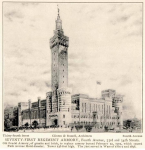
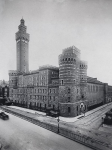
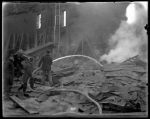 PARK AVENUE HOTEL
PARK AVENUE HOTEL
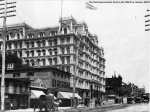 New York, NY Park Avenue Hotel Fire, Feb 1902 - part 2
New York, NY Park Avenue Hotel Fire, Feb 1902 - part 2
Submitted by Stu Beitler
Inmates of the Hotel Appear at the Window.
At this moment at the windows on the Park avenue side of the hotel appeared seven persons at different places. Of these four were women and three men. Some were fully clad, others only half so.
CLINTON FALLS, an adjutant of the Seventh Regiment, who has lived at the Park Avenue for some time, appeared at a window on the sixth floor. MR. And MRS. BRADLEY, who were to leave to-day on the transport McClellan for Manilla, appeared at a third floor window, at the Thirty-third street corner.
MRS. CHARLOTTE BENNETT and her husband, HAROLD, of Alabama, stood on a ledge on the fifth floor, just over the portico over the main entrance to the hotel. MRS. BENNETT was terror stricken and screamed again and again for some one to rescue her. Her husband grasped her, and from the crowd of thousands gathered in the streets there were shouted warnings not to jump.
Woman Jumps to Her Death From the Fifth Floor.
When it was seen that she was determined to jump, the firemen gathered in a circle and stretched out their arms. With a final desperate effort MRS. BENNETT wrenched herself free from her husband's grasp and with a piercing scream flung herself into the arms of the waiting firemen five stories below. When she jumped from the ledge on which she and her husband had stood the flames were licking out of the window behind her and around her form. The inside of the BENNETT'S rooms was all in flames.
MRS. BENNETT struck in the arms of the firemen. Her weight caused them to sag and the woman struck the pavement. She was terribly burned about the body. She was carried into the hotel by Fireman O'CONNOR and down into the cafe. There the hospital ambulance surgeons, who had been called, were at work. The woman was later taken to the Bellevue Hospital, where she died an hour afterward.
Her husband, when MRS. BENNETT jumped, disappeared back into his room. He was not seen afterward.
Thrilling Escape of MR. And MRS. BRADLEY.
MR. and MRS. BRADLEY appeared at a window on the fifth floor on the Park avenue side of the building, near Thirty-third street. MRS. BRADLEY appeared to be cool; her husband hysterical. MRS. BRADLEY stepped out of her window on an eighteen inch ledge. This ledge was covered with ice and snow.
On this narrow coping, with their bodies pressed close up against the hot walls of the building, MR. And MRS. BRADLEY crept hand in hand for over sixty feet to a point directly above the portico in the midle [sic] of the hotel, upon which a dozen firemen stood and from which they had raised ladders to the fifth floor. Then the two climbed down on the ladders, were helped down on to the portico, and from there down to the street by the aid of two score firemen.
When the couple had ended their dangerous walk along the hotel, and placed their feet upon the ladder, a cheer that was mighty went up from the crowd in the street. It was only equaled when the two were landed safely in the street, without scratch or burn.
Seventh Regiment Officer Calmly Awaits Rescue.
During all this time, twenty minutes having elapsed, Adjutant FALLS, tall and white-haired, stood on the ledge of the window of his room on the sixth floor. He was clad in white pajamas. Although the smoke was pouring out of the window all about him, he never once flinched and waited stoically until it was his turn to be aided down by the firemen. The crowd shouted words of encouragement to him.
Finally his turn came. Fireman O'BRIEN was ordered up from the top of the portico to FALLS' window, directly above, on a scalding ladder. O'BRIEN went to the top of the ladder, reaching to the fifth floor ledge only. From this he threw up the scaling ladder to the ledge on which FALLS stood. Five minutes it took to fasten the ladder. The ledge was icy and the ladder would not stick.
FALLS helped all this time. Finally he jammed the ladder down and it caught on the ledge. FALLS then descended the ladder to the portico, aided by Fireman O'BRIEN. When he was finally taken to the street he was almost overcome from exposure. As he went down the ladder it swayed and FALLS nearly fell. O'BRIEN then carried him down the rest of the way. He was taken into the hotel cafe, where he was treated by the Bellevue ambulance surgeons and later left. He secured some clothing and where he went was not learned.
Eleven Persons Rescued From the Sixth Floor.
Meanwhile Captain DONOHUE of truck No. 7 and a number of firemen had raised an eighty-five foot extension ladder up to the sixth floor on the Thirty-second street end of the hotel. From this ladder they carried down eleven persons, men and women, whose names they did not take, nor did the police secure them.
Three persons whose names are unknown, were rescued from the Thirty-third street end of the building.
Captain DELANEY of the East Thirty-fifth street station, went into the building, where, on the second floor he found an old woman, whose name is said to have been DYEA, almost unconscious from smoke. He picked her up in his arms and carried her to the stret [sic] by way of the main entrance of the hotel.
Gallant Work of the Fire Chaplains.
Chaplain SMITH of the Fire Department found BISHOP LUDDEN of Syracuse in his room on the seventh floor. He helped him to the street. BISHOP LUDDEN told the firemen then that there were, on the fourth floor, a number of other priests, including MONSIGNOR KENNEY, also of Syracuse. The fire chaplain returned into the building. He found his way through the smoke and up the stairs to the fourth floor.
He gathered the priests all together from two adjoining rooms and had them wrap wet towels about their heads. He then guided them down the stairs and through the rotunda into the office.
Chaplain WALKLEY of the Fire Department, at the head of the fifth stairway, stumbled over the body of Colonel ALEXANDER M. PIPER, U. S. A. retired, lying insensible on the carpet.
He found that Colonel PIPER had been overcome by smoke. He picked up the inert body and as best he could staggered down the stairway to the rotunda.
A Policeman Rescues Several Persons.
Policeman HODGINS of the East Twenty-second street station, found a MRS. BAUSCH sitting on the ledge of a window on the sixth floor on the Thirty-third street side. The woman is aged and partially paralyzed. She was clad only in her night clothing. With her was her nurse, AGNES SCHANZ.
HODGINS went through their rooms, pulled the two in from their perilous positions, and carried MRS. BAUSCH down the stairway, showing the nurse the way. He returned to the fourth floor and there found MR. And MS. WELD. Both were partially overcome by the smoke, and he carried them down the stairs. Half way down he met Father CONNOLLY, from Binghamton, who had lost his way, and did not know how to get out. He talked to the priest, telling him how to get out. In the meantime MISS SCHANZ had fainted. Father CONNOLLY turned about, picked up the unconscious form of the nurse and he and the policeman found their way downstairs through the blinding, choking smoke into the rotunda and thence into the street.
DR. ALBERT LEE SELLENINGS of 102 East Thirty-first street, Manhattan, a spectator to the fire, made his way into the hotel and on the third floor, in the hallway, found the form of an unconscious woman. She was carried out by him. The police did not obtain her name.
When MR. READ, the proprietor of the hotel, realized the magnitude of the fire he rushed upstairs to rescue his wife, who was asleep in her apartments on the fourth floor on the Thirty-third street end of the hotel. He made his way through the flames and smoke to get to her room, and when he got there he found the room vacant. He was badly burned about the hands and face. He ran downstairs again. There he made frantic endeavors to find his wife. At last he heard from the housekeeper of the hotel that his wife had been safely taken from her room downstairs.
Colonel BURDETT Killed While Dropping From a Window.
Colonel CHARLES L. BURDETT of the First Connecticut infantry, United States Volunteers, met his death in a terrible manner after making a heroic effort to save his life. His body, with the skull split open, was found shortly after 6 o'clock this morning by Detective Sergeants O'DONOHUE, CAPPER and KEANY. It was lying in the courtyard within the hotel.. BURDETT had fallen at least six stories.
COLONEL BURDETT was a guest on the eighth floor of the hotel. When the alarm of fire reached him escape was cut off. His room faced the court. Apparently he had dragged the mattress from his bed and dropped it to the roof of an extension over the hotel dining room several stories below. Then, by knotting the sheets together, he made a rope and secured it to the window. When his preparations were complete – they must have been finished in a few moments – he lowered himself on the improvised rope and then dropped. His design was to land on the mattress and thus have the frightful fall broken. He miscalculated the distance, went beyond the extension and was instantly killed, his head being crushed against the paved surface of the courtyard.
Brooklyn Eagle New York 1902-02-22
New York, NY Park Avenue Hotel Fire, Feb 1902 - part 2 | GenDisasters ... Genealogy in Tragedy, Disasters, Fires, Floods
